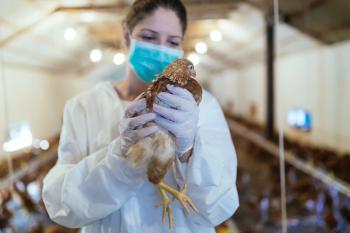
Global Influenza Surveillance Program Shows Promising Results
A program designed to improve the quality of influenza surveillance capabilities in 39 countries from around the globe through partnership with the Centers for Disease Control and Prevention (CDC) seems to have resulted in remarkable progress on all six of the assessed metrics, and even led to improvements in the surveillance of other pathogens, according to the results of a recent study.
A program designed to improve the quality of influenza surveillance capabilities in 39 countries from around the globe through partnership with the Centers for Disease Control and Prevention (CDC) seems to have resulted in remarkable progress on all six of the assessed metrics, and even led to improvements in the surveillance of other pathogens, according to the results of a study published in Emerging Infectious Diseases.1
Due to the constantly changing nature of influenza viruses, the vaccines developed to protect the populace require annual updates, driven by the specific influenza viruses infecting people throughout the world and their spreading patterns. This information is then compared against previously produced vaccines in order to determine their ability to protect against these viral strains. Because global data are required, the more countries participating in specimen submission for the development of seasonal vaccines, the more likely the vaccines are to be reflective of- and effective against circulating strains.
First author Lauren S. Polansky from the CDC in Atlanta, and her colleagues conducted a retrospective study in order to quantify the effects of an influenza virus surveillance capabilities enhancement program initiated in 2004 by the CDC’s Influenza Division in recognition of the threat posed by the highly pathogenic A(H5N1) avian influenza virus. The goal of the program was to strengthen international capacity to detect seasonal and pandemic influenza viruses, which would allow for more effective use of evidence-based risk reduction decisions.2-4 One of the pillars of the program was alignment with World Health Organization (WHO) guidelines and recommendations for strengthening national laboratory capacities, including designation as a WHO National Influenza Center (NIC).
The development areas of focus included in this study, as described by the authors, were, "1) achieving WHO NIC recognition; 2) improving weekly testing for influenza; 3) maintaining sentinel surveillance in ≥3 sites; 4) reporting weekly data to the WHO FluNet virus monitoring system; 5) sharing specimens with WHO collaborating centers for seasonal vaccine strain selection; and 6) increasing awareness of influenza disease by using national surveillance data to guide decision making for prevention and control strategies."
Study data were collected over a 10-year period from 2004—2013 and were derived from external WHO sources, as well as a 2013 retrospective questionnaire designed to collect information about capacity indicators from countries beginning the program between 2004–2009. During the first 5-year period, the program focused on capacity building, while the second 5-year period was focused on fostering sustainability. Only countries that transitioned into the second 5-year sustainability period and returned completed questionnaires were included in the data analyses.
The study results from the 35 countries that met entry criteria revealed significant improvements in all studied metrics. Additionally, most of the six areas of focus were found to contain multiple indicators of improvement. For example, the improved performance of influenza laboratories was demonstrated not only by an increase in the number of countries conducting routine virologic surveillance for influenza from 19 at the beginning of the capacity-strengthening program to 35 in 2013, but also by showing an increase in the number of countries using RT-PCR diagnostics from 11 in 2007 to 34 in 2013. In perhaps one of the most encouraging results for this metric, 28 (80%) countries reported adding additional pathogens to the routine platforms that were developed or enhanced through influenza virus capacity strengthening.
In describing the broader implications of their findings, Polansky and colleagues stated, "... considerable progress has been made in laboratory and sentinel surveillance capacities, which have proven to be essential building blocks for knowing which strains of influenza circulate globally, detecting and preparing for novel and pandemic influenza, understanding respiratory illness associated with influenza, and expanding public health surveillance beyond influenza." Therefore, the results presented in this publication should be considered very encouraging, as they suggest the ability of enhanced influenza virus vaccine surveillance programs to better protect humanity from what has been and continues to be a potentially lethal infection.
William Perlman, PhD, CMPP is a former research scientist currently working as a medical/scientific content development specialist. He earned his BA in Psychology from Johns Hopkins University, his PhD in Neuroscience at UCLA, and completed three years of postdoctoral fellowship in the Neuropathology Section of the Clinical Brain Disorders Branch of the National Institute of Mental Health.
References
- Polansky LS, Outin-Blenman S, Moen AC. Improved global capacity for influenza surveillance. Emerg Infect Dis. 2016 Jun. http://dx.doi.org/10.3201/eid2206.151521
- Bogich TL, Chunara R, Scales D, et al. Preventing pandemics via international development: a systems approach. PLoS Med 2012;9:e1001354. doi: 10.1371/journal.pmed.1001354. Epub 2012 Dec 11.
- Fleck F. How SARS changed the world in less than six months. Bull World Health Organ 2003;81:625—626.
- Beigel JH, Farrar J, Han AM, et al. Avian influenza A (H5N1) infection in humans. N Engl J Med 2005;353:1374—1385.
Newsletter
Stay ahead of emerging infectious disease threats with expert insights and breaking research. Subscribe now to get updates delivered straight to your inbox.

































































































































































































































































































